
Satellite Monitoring: Trump Card Of Agri Consultants
Latin America’s farming market takes around 26% of the world’s agriculture and is expected to soar in 5–6 years. This forecast has firm grounds. The region’s agriculture has strengthened thanks largely to modern technology — the Latin American precision agriculture market amounted to $1.21 billion in 2021, with the projected growth up to $2.13 billion in 2026.
Agricultural consultants play an important role in implementing agtech into farms’ daily operations. They serve as technical advisors for those agrarians who have little or no experience working with analytics tools — such as EOSDA Crop Monitoring platforms powered by satellite imagery — and need guided assistance. Utilizing satellite analytics in diagnostics and addressing crop development issues helps agri consultants achieve farm productivity and profitability growth for their clients, optimizing the use of human resources and agricultural inputs.
In this case study, we’ll cover the ways satellite-driven crop monitoring analytics assists Agronómico agricultural consultants in achieving remarkable results with their clients, Latin American farmers.
Overview: About Agronómico
Agronómico is a provider of high-tech services in soil management and agricultural research.
Agronómico‘s objective is to provide technical services and information to help producers and/or companies in the decision-making process in agriculture, with special attention to the technical management of soil and crops. For this purpose, Agronómico has laboratories, equipment, and highly qualified personnel to meet the needs of diagnosis and soil management to contribute to efficient agriculture.
Challenge: Reduce Use Of Fertilizers Without Compromising Yields
During the 1960s, Latin America’s contribution to the agricultural market was rather low. However, the situation changed with the increased usage of fertilizers. The application of NPK (nitrogen, phosphorus, and potassium) fertilizers rose to 250% within the last 50 years and reached 20 million tons per year, having been translated into farms’ productivity growth — each kilogram of applied fertilizer brought up to 5 additional tons of grains yearly. In particular, the soil enrichment led to outstanding crop growing results in Chile, Brazil, and Colombia.
Join the EOSDA Partner Program
Though fertilizers accelerate the region’s agricultural development, one nuance needs to be considered — most of them are imported. On average, 80% of NPK fertilizers depend on the international markets, being sensitive to price fluctuations. Nowadays, in the face of global food demand inducing the growing need for farming products, the agricultural inputs price is also increasing, which entails additional costs and impacts farms’ income. This situation urges the rational use of fertilizers to keep farming businesses efficient and profitable.
Solution: Enforce Сhemicophysical Soil Analysis By Satellite-Driven Analytics
The good old way to decide on the required amount of fertilizers is to measure soil fertility by chemicophysical analysis of field plots. Based on one soil sample, it’s possible to assume the whole field has the same condition, but will it be representative? Achievement of more accurate results demands that samples are taken regularly and from different areas; however, this approach can be rather expensive.
Since crop advisors’ objective is productivity with profitability, there should be other than traditional tactics to get relevant field data for decision-making.
By complementing a detailed soil analysis with smart agriculture platforms — and EOSDA Crop Monitoring is one of them — the agricultural consultant can significantly improve a farm’s financial performance.
Particularly for estimating the appropriate amount of fertilizers, the Zoning feature in EOSDA Crop Monitoring comes useful — this functionality allows for creating VRA (Variable Rate Application) maps for differential seed planting and fertilizing. A farmer can manually input the necessary amount of fertilizer for selected field parts according to the data retrieved from the processed satellite imagery and vegetation indices. Such a rational approach enables agriculturalists to cut expenses for frequent soil testing and apply proper dosing. To make fertilizer application as precise as possible, farmers have two types of maps at their disposal in EOSDA Crop Monitoring.
Vegetation maps help determine how much nitrogen the crops currently need. The map can be built on several vegetation indices; however, NDVI (Normalized Difference Vegetation Index) is used predominantly, being informative at almost every stage of crop development.
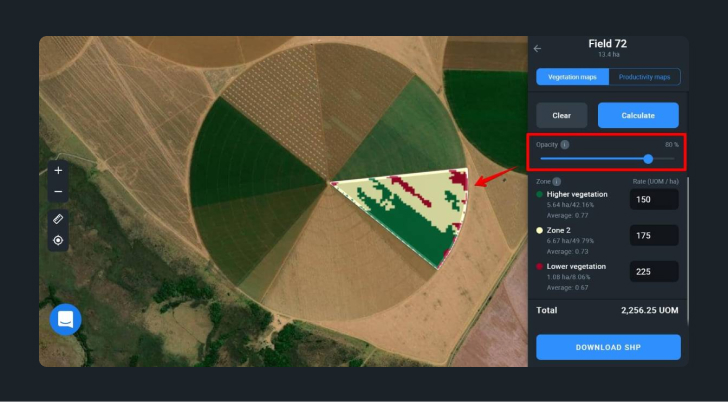
Productivity maps are used for the application of potassium and phosphorus according to higher or lower field productivity.
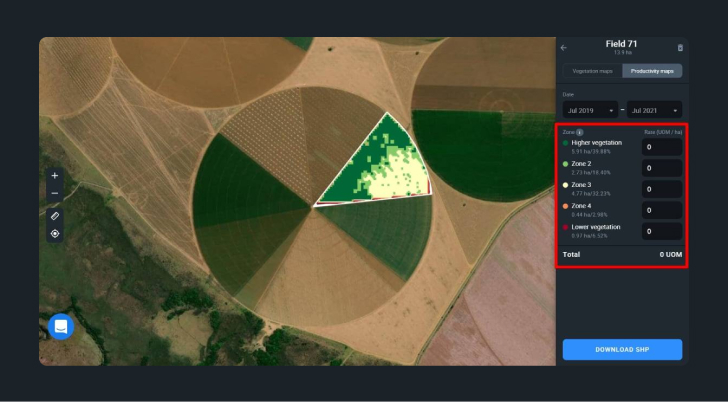
Both vegetation and productivity maps work perfectly as an addition to soil sampling providing a holistic picture of vegetation state and identifying problematic plots that require more attention. They also help accurately calculate the necessary amount of fertilizers and avoid unjustified expenses.
Vegetation indices are one more valuable feature for tracking crop development and timely identifying possible threats.
Among the most widely used indices are:
- NDVI (Normalized Difference Vegetation Index) that defines crop health depending on how the plant reflects light at certain wavelengths;
- NDRE (Normalized Difference Red Edge Vegetation Index) helping monitor crops in the maturity stage;
- RECl (Red-Edge Chlorophyll Vegetation Index) that detects the chlorophyll content in leaves and is informative during the active growth stages.
Outcome: Optimized Use Of Fertilizers And Increased Yields
The good thing about using satellite-driven analytics for field monitoring is that agricultural consultants can get preliminary information about the state of crops before field trips, spot problem areas, and thus focus right on them. Then, once the issue is detected, consultants estimate the necessary amount of fertilizers using the Zoning feature on the EOSDA Crop Monitoring platform, track how the crops’ state changes over time by checking vegetation indices, and correct the crop growing strategy. This “plan-do-check” approach undoubtedly leads to a farm’s productivity and profitability growth.
The example below shows significant improvement of a soy field vegetation state and yield after Agronómico’s client applied the recommended fertilizers based on soil chemistry and satellite imagery analysis.
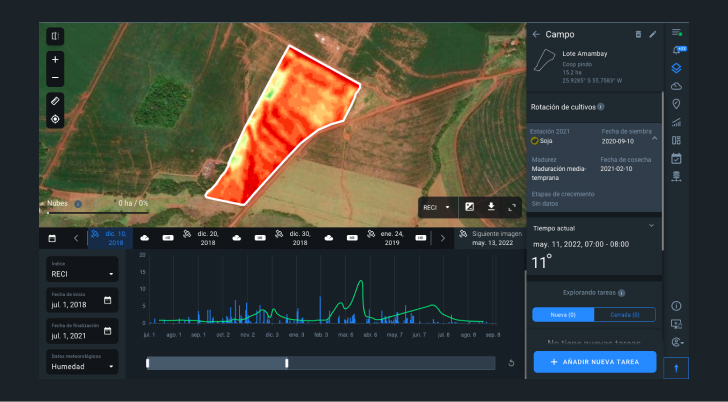
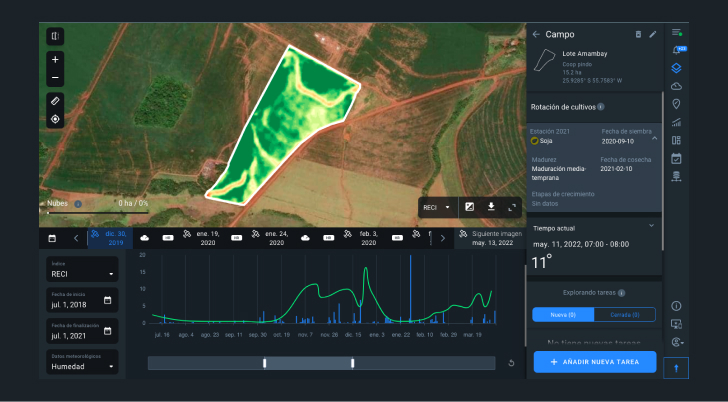
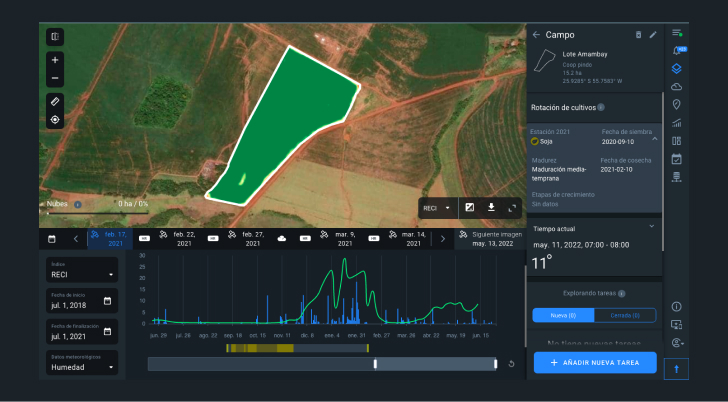
Rational application of fertilizers reduces supply costs and cares about soil microbial diversity averting soil degradation. Also, timely soil diagnostics prevents nutrient deficits and, strengthened by satellite-monitoring analytics, helps eliminate crop development issues at different growth stages. It wouldn’t be an overstatement to say that space-based technologies and agricultural consultancy are indeed the “power duo” capable of unleashing the real potential of every farm.
About the author:
Rim Elijah holds a double degree in business administration and political science from Stockholm University. As a VP of Sales at EOSDA, she oversees all aspects of business model development and implementation and the growth of the company’s global coverage. She has successfully established a number of strategic partnerships with an emphasis on sustainable solutions in Africa and Asia.
Recent articles

Analyze 2025 & Plan Your Best Year Yet: LandViewer Christmas Offer
It’s the most wonderful time of the year! The Christmas holidays are here, and so is your chance to analyze 2025 and plan a prosperous 2026 with more affordable Pro plans in LandViewer.

EOSDA Models Climate Change Impact On Sugarcane Yields
EOSDA modeled future temperature, rainfall, and other climate impacts on Veracruz sugarcane. The results help growers plan long-term adaptation strategies, including timing, varieties, and irrigation.

EOSDA LandViewer Black Friday Sale: Exclusive Offers & Giveaway
This Black Friday, LandViewer offers new users the chance to save on monthly plans, get extra months with yearly subscriptions, and participate in a free annual plan giveaway.